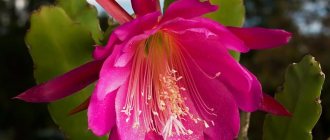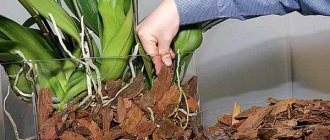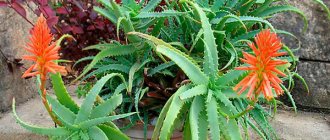Author: Elena N. https://floristics.info/ru/index.php?option=com_contact&view=contact&id=19 Category: Houseplants Published: February 27, 2019Last edits: January 11, 2021
- Growing from seeds
- Epiphyllum oxypetalum
Epiphyllum (lat. Epiphyllum) belongs to the genus of epiphytic plants of the Cactus family, numbering about 20 species. The name of the plant indicates the presence of leaves: επι in Greek means “on”, “on top”, and φυλλον - leaf. Sometimes epiphyllum is called phyllocactus or phyllocereus. Mexico, as well as the tropics and subtropics of America, are considered the birthplace of the flower. The epiphyllum plant was first described in 1812 by Adrian Haworth. Epiphyllum cactus is a popular houseplant.
Planting and caring for epiphyllum
- Flowering: usually from April to June, sometimes blooming twice a year.
- Lighting: bright diffused light (western or eastern window sills).
- Temperature: during the period of active growth – 20-25 ˚C, from November to February – 10-15 ˚C.
- Watering: during the growing season - regularly, as soon as the top layer of the substrate dries. In winter you don't have to water.
- Air humidity: does not matter much, but in extreme heat it is recommended to spray the plant with warm water in the evenings.
- Feeding: during the growing season - 2 times a month with fertilizers for cacti, at the stage of bud formation - with mullein solution (1 part fertilizer to 4 parts water). During the dormant period, fertilizing is not needed.
- Dormant period: from late October to March.
- Transplantation: young plants are replanted annually, in the spring, at the beginning of active growth. Mature - after flowering, in case of emergency.
- Reproduction: seeds and cuttings.
- Pruning: in the spring, before the start of the growing season, thin, faceted and round shoots, as well as those that bloomed 2-3 years ago, are removed once every 2-3 years.
- Pests: aphids, scale insects, spider mites, mealybugs.
- Diseases: black rot, fusarium, rust or anthracnose.
Read more about growing epiphyllum below.
Emerging problems
Diseases
Diseases affecting Epiphyllum are:
- Rust occurs from waterlogging of the soil during cooling, from the accumulation of moisture on the stem, or from burns by the rays of the sun. It looks like untidy spots of a rusty hue. Treatment with a fungicide and regulation of care conditions is necessary.
- Black rot affects the stems - spots with a black sheen. Control - removal of affected areas and chemical treatment.
- Anthracnose is a light brown spot. It is necessary to cut out diseased stems and spray with fungicide.
- Fusarium rotting of roots from chronic waterlogging and redness of stems. You should remove diseased roots, replant the plant and monitor watering.
Pests
Among the pests that are especially dangerous for Phyllocactus are:
- Spider mites - they suck nutritious juices from the plant and appear in fairly dry conditions. Control measures include increasing humidity and treating with acaricide.
- Aphids - by sucking cell sap, disrupt the development process of the cactus, and in addition, they are a carrier of viruses. Insecticide treatment required.
- Mealybugs slow down the growth of the cactus by sucking out nutritious juices and leaving a waxy coating. The plant is infected with viral diseases. To eliminate the pest, you need to wipe the cactus with alcohol or a detergent solution. If necessary, apply chemical treatment.
- Scale insects harm the development of the plant. Control measures include inspecting the stems and removing bugs. As a last resort - chemical treatment.
Botanical description
Epiphyllum, or phyllocactus, or forest cactus, is a succulent plant with long, branching stems, drooping or creeping, sometimes with wavy edges. The stems can be flat or triangular, they are equipped with aerial roots. It is these stems that are mistakenly called epiphyllum leaves. The large, white, funnel-shaped phyllocactus flowers can reach a length of 40 cm and open both day and night. They are so beautiful that the plant is called epiphyllum orchid. Epiphyllum fruits are large, often prickly, reddish in color, edible, with a banana-pineapple-strawberry flavor.
Most often, epiphyllum is grown as an ampelous plant.
Caring for epiphyllum at home
Growing conditions
Caring for phyllocactus at home does not contain any difficulties. If you want to see its magnificent bloom, keep the epiphyllum flower on the windowsill of a window facing west or east: the lighting should be bright, but diffused. In summer, epiphyllum feels great in the fresh air, but exposing the plant to direct sunlight at midday is undesirable.
- Zamia – care, photos, types
In the warm season, the most comfortable temperature for phyllocactus is 20-25 ºC, and from November to February, when the plant rests, the temperature should not be higher than 10-15 ºC. Epiphyllum is rather indifferent to air humidity, but in the hottest weather it will benefit from daily spraying with settled water at room temperature.
Caring for a phyllocactus involves regular watering, which is also carried out with settled water at room temperature, as soon as the top layer of soil in the pot dries. In summer you will have to water more often, in winter less often. If the epiphyllum overwinters in a cool room, watering can be stopped altogether. With the beginning of spring, soil moisture in a pot with epiphyllum is resumed and gradually increased.
Epiphyllum at home needs fertilizing: in the spring and summer, twice a month, a cactus fertilizer solution prepared in accordance with the instructions is added to the soil. During the phase of formation of buds at the epiphyllum, the plant is fed with mullein - 1 part of the fertilizer is diluted in 4 parts of water. After flowering, the phyllocactus is fed every two weeks, alternating organic feeding with the application of mineral nitrogen fertilizers for indoor plants. During the dormant period, phyllocactus does not need feeding.
Epiphyllum bloom
As soon as buds begin to form on the epiphyllum, do not move or even rotate the pot of the plant under any circumstances, because it may drop both buds and flowers. Phyllocactus flowers bloom alternately, and each of them blooms for about a week. Some species and varieties of plants bloom twice a year - in spring and autumn. Make sure that the plant has enough moisture and nutrition during flowering. Place it on a tray so that excess water flows out of the pot without interference and does not stagnate in the roots of the plant.
Trimming
Growing phyllocactus involves periodically pruning it as the stems grow.
How to trim epiphyllum? And how often should this be done? Epiphyllum pruning involves removing faceted or round stems that never produce flowers, and shortening flat stems. When pruning flat stems, remember that the flowers of the plant form on stems that have grown over the past year, so older stems that have already bloomed will not form flowers again, but they can only be pruned after 2-3 years, because they are necessary for ensuring the life of the plant. The stems on which cork formations appear must be pruned.
Curved stems or stems growing inside the bush, as well as faded buds, are cut out from the epiphyllum. Sections of stems are treated with crushed coal.
Why doesn't it bloom
There are times when, despite your expectations, the phyllocactus does not bloom in due time. Why doesn't epiphyllum bloom? What could be the reasons for this? Insufficient lighting, too much watering in winter, when the epiphyllum rests in a cool room, wintering in warm conditions and excess nitrogen in the soil.
How to make epiphyllum bloom
Epiphyllum blooms when the plant is in comfortable conditions. If your phyllocactus refuses to bloom, it means that you have somehow violated the rules of caring for the plant. Check if it has enough light, moisture and nutrition. Stop applying fertilizers with a nitrogen component for a while. Give it the opportunity to rest from November to February in a cool room at a temperature no higher than 12 ºC, and most likely the plant will bloom next season.
Transfer
Young epiphyllums that grow quickly are replanted annually in the spring, but try not to use a pot that is too large for replanting. Transplantation of mature epiphyllum is carried out after flowering and only if necessary, when the roots of the phyllocactus appear from the drain hole. Epiphyllum needs not a tall, but a wide pot made of ceramic or plastic, on the bottom of which you must place a layer of expanded clay, broken polystyrene foam or pebbles for drainage.
The soil for the plant can be purchased at the store or prepared independently: mix four parts each of turf and leaf soil, adding to them one part each of charcoal, fibrous peat and coarse sand. Do not include ingredients containing lime in the substrate - the optimal pH of the substrate for epiphyllum is pH 5-6.
Pests and diseases
Among the pests that affect epiphyllum are aphids, scale insects, spider mites, and mealybugs.
Mealybugs, or hairy lice, are sucking insects that feed on plant sap and leave a waxy, cotton-like coating on it. As a result of their appearance, the epiphyllum begins to lag behind in development. But the worst thing is that scale insects are carriers of incurable viral diseases.
- Caring for indoor plants while on vacation
To get rid of pests, wipe the above-ground parts of the plant with a soft brush or cotton swab soaked in alcohol or soap solution, removing the scale insects and washing away traces of their vital activity, and in case of severe damage, triple treat the plant with Aktara, Confidor, Mospilan or Fitoverm at intervals between sessions in seven days.
Aphids are also sucking insects that appear seemingly from nowhere and not only feed on the cell sap of the epiphyllum, causing the plant to stop growing, developing and begin to wither, but also transmit viruses. Drugs such as Antitlin and Biotlin are effective against aphids.
Spider mites infect plants under conditions of chronic lack of moisture. They, just like scale insects and aphids, suck the juices from the epiphyllum, disrupting the normal course of its development. In the fight against ticks, insectoacaricides are used - Aktara, Aktellik and the like.
Scale insects are small bugs with a hard back. These pests also deprive the phyllocactus of juices and strength. The scale insects are removed mechanically, after which the plant is treated with a systemic insecticide. If necessary, the treatment is repeated after two weeks.
Sometimes epiphyllum is affected by diseases such as black rot, fusarium, rust or anthracnose.
Black rot covers the stems of the plant with black shiny spots. The affected areas are cut out, the sections are treated with crushed coal, and the plant is treated with Fundazol solution.
Rust appears as red spots on the surface of the stems. The disease is provoked by excessive watering at low air temperatures, sunburn or water getting on the stems when watering. If symptoms of the disease are detected, the plant should be treated with a solution of Topaz.
Anthracnose can be recognized by light brown spots on the stems of phyllocactus. The affected areas should be cut out and sprinkled with coal, and the plant should be treated with some fungicide.
Fusarium causes a change in the color of phyllocactus stems from green to reddish or brown - this is caused by rotting of the plant's root system.
How to save epiphyllum if the roots are rotten? Transplant the plant into a new substrate, cutting out the rotten roots and treating the cuts with ash. After replanting, reconsider the watering regime - most likely, you have allowed the root system to become chronically waterlogged, and this has created a fertile environment for the development of a fungal infection.
Health problems with phyllocactus also occur when the conditions of its maintenance are violated:
- its leaves may dry out and wrinkle from too much light and insufficient watering;
- if you move the pot to the wrong place, the growth of the epiphyllum may stop, the already formed buds and flowers will fall off at once, and the leaves will change color;
- due to damage to the roots during transplantation, the stems of the plant begin to dry out and die, and due to excess fertilizer, the shoots crack.
But still, the worst thing is when the roots of the epiphyllum rot. It happens not only from fusarium, but also from excess moisture in the roots, from watering the plant with cold water, or from overheating a pot with epiphyllum in the sun. We have already told you how to save the epiphyllum in case of root rot: the only way out is to transplant the epiphyllum into a fresh substrate, first removing the diseased roots and treating the cuts with crushed coal. And, of course, it is necessary to correct all mistakes in caring for the plant.
What to do if the plant does not bloom?
Sometimes gardeners have a problem - the epiphyllum does not bloom. Its growth can occur with standard care, but the formation of buds is not observed. How to make a cactus bloom? This requires creating special conditions. It is necessary to create the right conditions in winter, since the quality of this determines flowering in the summer months. To stimulate flowering, you should use the following recommendations:
- At the end of February, when the cactus begins to form buds, it should not be transported or rotated to preserve them;
- In March, intensive watering should be carried out. It is necessary to constantly monitor the level of soil moisture;
- Old shoots need to be cut off, since the epiphyllum spends energy on them that it could spend on flowering;
- The cactus container should be quite tight.
If all care measures are followed, there should be no problems with flowering. This is a capricious plant, and therefore you should carefully monitor it.
Reproduction of epiphyllum
Growing from seeds
Epiphyllum propagates by seeds and vegetatively - by stem cuttings and dividing the bush. Seed propagation of epiphyllum does not contain any difficulties: the seeds are sown in a moist substrate for cacti, placed in bowls, covered with film and kept at a temperature of 20-23 ºC, lifting the cover daily for half an hour or an hour for ventilation, and when spiky faceted shoots similar to cacti appear , polyethylene is removed completely. Over time, the stems become flat, lose their thorns and, with proper care, begin to bloom within 4-5 years of life.
Dividing the bush
A large specimen of epiphyllum can be divided into parts during transplantation. This is done after flowering. The epiphyllum removed from the pot is divided into parts, each of which should contain young, healthy stems and strong roots. Rotten or dead roots of the separated parts are cut off, the sections are treated with crushed charcoal, after which the divisions are planted in separate bowls with drainage and substrate for phyllocactus, the composition of which we described in the section on epiphyllum transplantation. At first, the planted plants are protected from light and watered little by little.
Cuttings
This method of propagating phyllocactus is used from the beginning of April to the end of May. Stems 10-13 cm long are cut from the mother plant, making a wedge-shaped cut on their lower part, and they are placed in a dry container for a couple of days so that the juice flows out through the cuts, after which they are dropped to a depth of 1 cm into a substrate consisting of three parts of soil and one part of perlite, and after planting the cuttings, the surface of the substrate is sprinkled with a layer of sand 2 cm thick. The pot for cuttings is chosen to be flat, no more than 7 cm high. The cuttings are kept in the shade and watering begins only two days after planting.
- Types of Smithianta with names and photos
Types and varieties
Among the epiphyllums grown in culture, there are many both natural plant species and hybrid ones. Most often in culture you can find:
Epiphyllum oxypetalum
Or sour-petaled - a large plant, reaching a height of three meters, with twig-like, woody in the lower part, flat, wavy along the edge stems up to 10 cm wide and white flowers up to 20 long and up to 18 cm in diameter. Hybrid forms of this species vary in size and color flowers;
Epiphyllum anguliger
Or epiphyllum angularis - a highly branched bush-like plant with dark green, woody, round, and sometimes triangular stems in the lower part, and flat or triangular stems in the upper part, up to 1 m long and 4 to 8 cm wide. Large, fragrant bright red flowers can reach 8-10 cm in diameter;
Epiphyllum hookeri
Or Epiphyllum acupetallum, can be found in natural conditions in Cuba, Venezuela and Mexico. There, plants of this species reach enormous sizes. This is a white epiphyllum - its long stems, decorated with large white flowers with an inexpressive aroma, bend downward in an arc under the weight of their own weight and hang down to the ground;
Serrated epiphyllum (Epiphyllum crenatum)
It is a semi-epiphytic cactus - a bush with bluish-green stems up to 70 cm long and up to 10 cm wide with deep and frequent cuts along the edges and with fragrant flowers up to 15 cm in diameter. This species also has many hybrid forms that differ from each other in the color of the flowers ;
Epiphyllum phyllanthus
South American phyllocactus with shoots up to 1 m long, secondary leaf stems of which reach a length of 25 to 50 cm, and pink flowers 15 to 18 cm in diameter;
Guatemalan Epiphyllum (Epiphyllum guatemalense)
It has a special shape of stems: they look like a chain of interconnected oak leaves, each 5 cm in size. This species has a form called monstrosa, in which the stems change shape and twist randomly. Epiphyllum Guatemala has flowers of different shades of pink;
Epiphyllum thomasianum
In nature, the length of the stems of this species reaches 4 m, but at home - no more than 70 cm. The flowers are large, white, with a yellow center, about 25 cm in diameter;
Epiphyllum ackermanii
A bush with drooping stems, which are flat multi-toothed shoots at a height of 4-7 cm from the base. This is red epiphyllum - its fiery flowers form on thin shoots and look very touching;
Epiphyllum laui
A fast-growing epiphytic and lithophytic phyllocactus, the main stems of which have a diameter of up to 2 cm, and the side stems up to 7 cm. The shoots are equipped with yellowish-brown hair-like needles up to 4 mm long. The white-cream flowers of this species open in the evenings and do not fade for about 2 days.
Of the hybrid epiphyllums, the most popular are:
- an unnamed hybrid bred by Frank Nunn. The white color of the middle of the flower of this plant gradually turns into a light pink tint, and the edges of the petals are painted bright purple;
- King Midas is a hybrid with dark green stems up to one and a half meters long and with large flowers with a diameter of 16.5 cm of a yellow-orange, almost golden hue;
- Just Pru - this hybrid has flowers with a diameter of 12-16 cm, light pink in the middle and dark pink at the edges of the petals;
- Johnson's epiphyllum is a hybrid that blooms with dark scarlet flowers;
- Wendy May - bright crimson flowers of this epiphyllum of an unusual shape: the petals located at the edges are sharp and long, and those in the middle are short, with rounded ends;
- Jennifer Ann - phyllocactus with large lemon-colored flowers;
- Martina is a hybrid variety with cascading stems that seem to be divided into small oval segments. The flowers are elongated, red with a light yellow center, and have a pungent odor.
Phyllocactus fruits
Epiphyllum can bear fruit even at home. This requires artificial cross-pollination. The fruits are often covered with spines and are similar in shape and size to plums. Their color depends on the shade of the flowers.
There are yellow-green or purple fruits. You can eat them. The pulp has a pleasant sweetish taste, reminiscent of a mixture of pineapple and strawberries. The fruits are eaten separately, like fruits or berries, and are also added to various dishes. Pre-cleaned from thorns. The fruits are used in folk medicine. Infusions, ointments and compresses are prepared from the pulp.
These remedies help in the treatment of headaches, colds, diseases of the cardiovascular, genitourinary and nervous systems, gastrointestinal tract, skin and joint diseases. The fruits are especially widely used in the fight against psoriasis.











